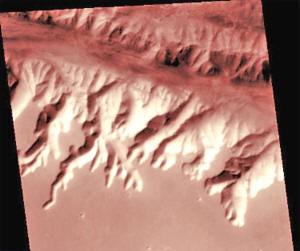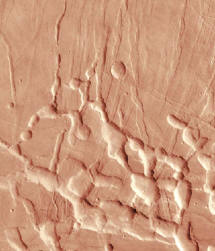|
|
|
by David Talbott from Thunderbolts Website
May 16, 2005
Upper credit:
NASA/JPL/Arizona State
The greatest canyon in
the solar system, Valles Marineris on Mars, underscores the contrast
between two interpretations of the planet’s history. Now,
high-resolution images of the chasm cast new doubts on old
explanations.
The “planet of a thousand mysteries” is more than an unusual member of the solar system. It has emerged as a laboratory in space for the exploration of solar system history. And the story it has to tell is so different from the things we learned in school that a retreat from all prior doctrines is now essential.
Current geologic concepts, based on
terrestrial observations of volcanism, erosion, and shifting
surfaces, fail to account for the features of Mars, and the history
and geology of Mars that have been built on those concepts is
incomprehensible. But letting go of a cherished belief system often
requires a shock.
In our Picture of the Day for April 08, 2005 “The Thunderbolt that Changed the Face of Mars”, we suggested that Valles Marineris was created within minutes or hours,
But what will it take for planetary scientists to consider a new way of seeing Valles Marineris?
It will require a willingness to reconsider all assumptions, without prejudice. A prejudice is an unfounded assumption that leaves one in a state of partial blindness. On the matter of Martian history in general, and Valles Marineris in particular, the most powerful prejudice is an untested supposition, the bane of space age science: the idea that planets have moved on their present courses for billions of years.
No one
should have the intellectual privilege of asserting such an idea as
dogma. The idea originated as a guess and then, in the absence of
any definitive evidence, crystallized into a doctrine held in place
only by the inertia of belief.
Did evolution of the planet in isolation produce this vast bulge? And what of the trench itself? Traditional geology cannot explain in a plausible way Valles Marineris!
Here, for example, is the “explanation” offered in a recent release by the European Space Agency:
The anomalies and exceptions to this litany of standard geologic processes reduce the applicability of standard theory to the point of leaving nothing that it explains.
In the electric view, the electric force raised the Tharsis bulge,
along with the surface “blisters” of Olympus Mons and its companions
to the west, and a planetary-sized electric arc cut Valles Marineris
into the bulge.
To illustrate the point we offer a close-up
view (lower image) of a small section of the western end of the
canyons of Valles Marineris - Tithonium Chasma and Ius Chasma (marked
by the white box in the context picture above). The second (lower)
picture, with a resolution of 52 meters per pixel, shows the neatly
“machined” look predicted by the electrical arcing hypothesis.
Of this pattern, predictable under the electric hypothesis, the Valles Marineris provides many instances.
We have placed two examples in below images:
For a time, the most plausible instance of surface spreading was Labyrinthus Noctis, the chaotic region to the west (left) in the upper top picture. In particular, that explanation seemed plausible in the earlier Mariner probe image seen below.
Some scientists had compared this region to the cracked surface of a loaf of bread as the surface is raised and spread during baking. But more recent pictures show something quite different.
Above we see the same indications of cleanly cut trenches or channels now revealed throughout Valles Marineris, though the pattern is more chaotic and the depressions more shallow.
From an electric viewpoint, the stupendous arc that cut Valles Marineris was diffused into secondary filaments before being quenched. As seen in numerous counterparts on Mars, the depressions of Labyrinthus Noctis appear as complexes of crater chains and flat valleys, cut by the same force that created the overlapping craters elsewhere on Mars.
The surface areas untouched by the arc thus remain as buttes and surrounding plains above scalloped cliffs.
The smooth surfaces above the valleys show no evidence of rifting or of the supposed stressed that are claimed to have "torn" the surface, just a complex of even more shallow, flat-bottomed and often parallel grooves, a recognized signature of electric arcing.
|






